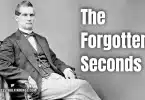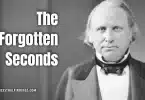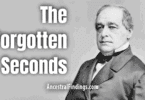George Mifflin Dallas, who served as the 11th Vice President of the United States from 1845 to 1849 under President James K. Polk, is one of the quieter figures in American history. Though the city of Dallas, Texas, may or may not be named after him, his influence was far greater in his own time than the legacy we associate with his name today. He was a man of learning, diplomacy, and political acumen, with roots that reached deep into the early fabric of American life.
The Dallas Family Line: From Scotland to the New World
George Mifflin Dallas was born on July 10, 1792, in Philadelphia, Pennsylvania, a city deeply intertwined with the story of American independence. His family was not just present at the founding of the republic—they were actively shaping it.
His father, Alexander James Dallas (1759–1817), was born in Kingston, Jamaica, to Scottish parents. The Dallas family hailed from Morayshire, Scotland, where the surname is traced back to at least the 13th century. The name comes from a place name near Elgin, likely derived from the Gaelic dail eas, meaning “meadow of the waterfall.” The family had Scottish Highland roots but spread throughout the British Empire during the 18th century.
Alexander Dallas left Jamaica as a young man, was educated in Edinburgh, and eventually immigrated to Philadelphia. He quickly rose through the legal and political ranks, becoming Secretary of the Treasury under President James Madison during the War of 1812. Alexander’s time in office saw the stabilization of American finances after the destruction of the first Bank of the United States.
George’s mother, Arabella Maria Smith, descended from a prominent Pennsylvania family. Her father, William Smith, had connections to the region’s political and mercantile circles. Arabella’s line may also connect to the extended Smith family of Maryland and Pennsylvania, including members of the colonial elite. In naming their son, George’s parents honored their close family friend and Revolutionary leader Thomas Mifflin, who had served as the first Governor of Pennsylvania and a president of the Continental Congress. Mifflin’s influence was both political and personal for the Dallas household.
Youth, Education, and the World Stage
George Mifflin Dallas was raised in an atmosphere of education, diplomacy, and political action. He attended elite private academies and later studied at the College of New Jersey, which later became Princeton University, graduating with honors in 1810. At just 18 years old, Dallas had already shown promise in legal reasoning and public speaking.
Initially inclined toward the legal profession like his father, George began studying law under prominent Philadelphia attorneys. However, the international conflicts of the early 19th century quickly drew him away from the legal desk. During the War of 1812, Dallas served as private secretary to Albert Gallatin, the U.S. Minister to Russia, and traveled to Europe at a young age. He gained firsthand experience in diplomacy, European politics, and the art of negotiation.
Upon returning to the United States, Dallas was admitted to the bar and briefly worked as a lawyer. Yet, public service proved too appealing. His family’s political connections and his abilities helped him advance into increasingly essential positions in the federal and state governments.
Political Rise in Pennsylvania and Washington
By the late 1820s, George M. Dallas was rising steadily through the political ranks. He was appointed U.S. Attorney for the Eastern District of Pennsylvania in 1829 and then elected as Mayor of Philadelphia in 1828, though he served for only a short time. That same year, he filled a vacancy in the U.S. Senate, where he served until 1833.
In the Senate, Dallas aligned himself with the Jacksonian wing of the Democratic Party. He supported President Andrew Jackson during the heated debates over the rechartering of the Bank of the United States, which was headquartered in Philadelphia. His anti-bank stance aligned with the populist sentiment of the time but put him at odds with many of the business interests in his home state.
After his Senate service, Dallas held other federal roles, including Minister to Russia under President Martin Van Buren. His time in Russia (1837–1839) solidified his reputation as a skilled diplomat and confirmed his status as a loyal and capable member of the Democratic Party’s national leadership.
Vice President of the United States (1845–1849)
Dallas’s most significant national role came when he was chosen as the Democratic vice-presidential nominee in 1844. James K. Polk, a dark horse candidate from Tennessee, needed a running mate who could shore up support in the industrial North. Dallas, with his Pennsylvania background, fit the bill perfectly.
The Polk-Dallas ticket narrowly defeated Henry Clay and the Whigs in a contentious election. Once in office, Polk focused on expansionist policies, including the annexation of Texas, the acquisition of Oregon, and the Mexican-American War, which would ultimately lead to the annexation of much of the American Southwest.
As Vice President, Dallas presided over the Senate and cast several tie-breaking votes. His most consequential decision was casting the deciding vote on the Walker Tariff of 1846, which significantly reduced tariff rates. While this vote aligned him with Southern and Western Democrats, it angered the protectionist industries of Pennsylvania—Dallas’s home state. This single vote likely ended any future chance he had of national office.
He remained loyal to Polk throughout the administration and did not publicly criticize any of the president’s decisions. While there was some quiet support for Dallas as a potential presidential candidate in 1848, the Democratic nomination went to Lewis Cass instead.
Later Years and Diplomatic Service
Following his term as Vice President, Dallas returned to Philadelphia and resumed his legal career. He mainly stayed out of the public eye until 1856, when President Franklin Pierce appointed him Minister to Great Britain. During this time, U.S.-British relations were tense due to disagreements over Central America, slavery, and maritime rights, but Dallas handled the post with professionalism and restraint.
He returned to the United States in 1861, as the Civil War began. A committed Union man, he supported the government but largely stayed retired from political life. He died on December 31, 1864, in Philadelphia and was buried at St. Peter’s Episcopal Churchyard.
Marriage and Descendants
Dallas married Sophia Chew Nicklin, the daughter of a wealthy Philadelphia merchant and a member of the prominent Chew family—one of the oldest and most distinguished families in colonial Pennsylvania. The Chews were deeply rooted in Philadelphia society and had connections to legal, political, and military leaders dating back to the colonial period.
George and Sophia had several children, although few of them entered politics. Their family continued to be part of the city’s social and legal circles but did not hold national office.
Was Dallas, Texas, Named for Him?
It’s a widespread belief that the city of Dallas, Texas, was named after George Mifflin Dallas, mainly since the town was founded in 1841 and incorporated in 1856—while he was nationally prominent. However, no definitive proof exists. Other possible namesakes include his brother Commodore Alexander J. Dallas or even Joseph Dallas, an early settler. Regardless of the actual origin, the association with George M. Dallas has persisted for generations.
Conclusion
George Mifflin Dallas was a man of diplomacy, law, and moderate politics—someone who sought to serve the country more than his ambition. While he never became president, his contributions as a vice president and statesman left a steady hand during a time of national expansion and growing division. His lineage traces back through Scotland and the British Caribbean, through revolutionary Philadelphia, and into the early halls of American power.
He is remembered today more in name than deed. Still, those who look deeper will find in Dallas a fascinating window into the mid-19th century political world—a man shaped by heritage, opportunity, and quiet dedication to duty.






